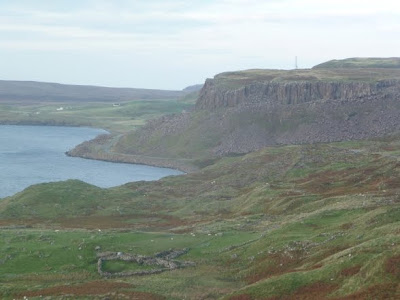We spent two uneventful days at the Glen Nevis visitor center, not bothering anyone, the alternating squalls and gales affording me the opportunity to catch up on the blog and to rest up from the Ben. We even got a few river-walks in between the showers and deluges. Tuesday afternoon, however, after dutifully paying our "donate and display" fee, we noticed they had erected a "no overnight parking" sign. The nerve! So, as the sun set, feeling a bit dejected, we pulled up stakes, drove through Fort Bill and down (up?) the loch a couple miles until we found a more hospitable, unsigned, lay-by.
Wednesday we drove through continued rain and wind to Glencoe, checked out what we were missing at the visitor center--it is a marvelous hill-walking area--and then drove on through the squalls, skirting the Trussochs, the QE2 national forest, to the ancient capital, Stirling, and its historic castle. Stirling occupies a sort of geographic narrows in Scotland and through its history has been a highly contested place. After doing the castle tour and the associated Argyll House, we drove out to Bannockburn, the site of the Scots' greatest victory over the English, in 1314. And from there we drove on to Falkirk and the Falkirk Wheel, where we presently are parked. We'll see the Wheel tomorrow morning and then head on to Glasgow.
 |
Glencoe, in the rain; people go walking in this?
|
 |
Stirling Castle walls
|
 |
Royal residences of various James, Marys, et al.
|
 |
The Rood, where important coronations occurred
|
 |
The Argyll House, another 17th century aristocratic abode I couldn't get into except
for noticing... |
 |
This woman's huge right bicept; too much caber-tossing?
|
 |
The Mel Gibson, I mean, Willam "Braveheart" Wallace memorial, from the Castle
|
 |
Robert the Bruce statue at Bannockburn
|















































